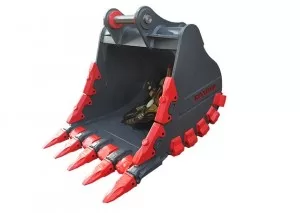Choosing the Right Thumb Bucket for Excavation - Bonovo
Selecting the appropriate equipment is essential for excavation projects. The thumb bucket is a critical component that can significantly impact the success of these projects.The thumb bucket is an attachment that enhances the functionality of an excavator, allowing for precise and efficient material handling. However, choosing the right thumb bucket can be a daunting task, as it involves considering various factors such as material type, weight, and size.

1. Material Type:
The type of material you will be excavating is a crucial factor in determining the appropriate thumb bucket. Different materials have varying properties, such as density and abrasiveness, which can affect the performance and durability of it. For example, if you are working with loose or granular materials such as soil or sand, a thumb bucket with wider tines and larger gaps between them would be ideal for efficient material retention. On the other hand, if you are dealing with heavier materials like rocks or concrete, a thumb bucket with narrower tines and smaller gaps would provide better gripping capabilities.
2. Weight:
The weight of the material being excavated is another important consideration when selecting a thumb bucket. Heavy materials require a robust and durable bucket that can withstand the stress and strain of lifting and moving them. It is essential to choose a thumb bucket that matches the weight capacity of your excavator to ensure safe and efficient operation. Additionally, consider the weight of itself, as a heavier attachment can affect the overall performance and stability of the excavator.
3. Size of Thumb Bucket :
The size of the thumb bucket should be compatible with the size of your excavator and the scope of your excavation project. A thumb bucket that is too small may not have sufficient capacity to handle large volumes of material efficiently, leading to increased downtime and decreased productivity. Conversely, a thumb bucket that is too large may be cumbersome and difficult to maneuver, resulting in slower operation and potential safety hazards. It is crucial to select a thumb bucket that strikes the right balance between capacity and maneuverability for optimal performance.
4. Design Features of Thumb Bucket :
When choosing a thumb bucket, consider its design features that can enhance its functionality and durability. Look for features such as reinforced tines and cutting edges, which can withstand the wear and tear of excavation work. Additionally, consider features like replaceable teeth or tines, which allow for easy maintenance and prolong the lifespan of the thumb bucket. Some buckets also offer adjustable tine spacing or hydraulic capabilities, providing greater versatility and adaptability to different excavation tasks.
5. Consultation with Experts:
If you are unsure about which is best suited for your excavation project, it is always advisable to consult with experts in the field. Equipment manufacturers or dealers can provide valuable insights and guidance based on their expertise and experience. They can assess your specific requirements and recommend the most suitable thumb bucket that aligns with your project goals and budget.
In conclusion, choosing the right bucket for your excavation project is crucial for optimal performance and efficiency. Consider factors such as material type, weight, size, and design features when making your selection. By taking these factors into account and seeking expert advice when needed, you can ensure that your excavation project is equipped with the right thumb bucket for success.




